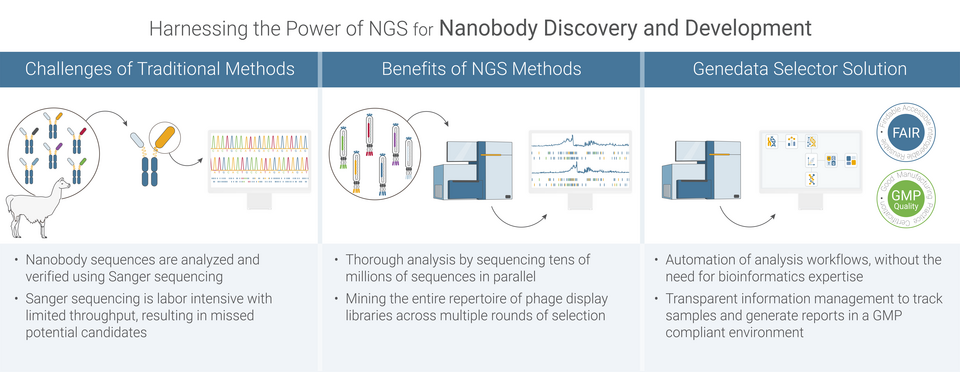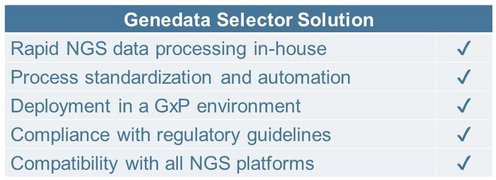Harnessing the Power of NGS for Nanobody Discovery & Development
October 2, 2023
Raed Hmadi
In the rapidly evolving space of biopharmaceutical R&D, Next-Generation Sequencing (NGS) has become a powerful tool in the discovery and development of antibodies (Abs) and antibody-like molecules. A variety of NGS methods have been developed in recent years, for example, to assess the quality of antibody libraries, define sequence-based liabilities, and optimize developability. Although NGS-based assays provide comprehensive insights during the R&D process, their in-house implementation remains a significant challenge for many organizations. This is due to the substantial volume and intricacy of the NGS data generated and processed, which frequently necessitates advanced bioinformatics analysis and data management. In this blog, we will explore how bringing NGS in-house can be used to advance Nanobodies, a class of antibody-like molecules, that are gaining popularity in biopharmaceutical R&D due to their numerous advantages.
Understanding Nanobodies
Nanobodies are derived from heavy-chain-only antibodies found in sharks and members of the Camelidae family, including llamas, alpacas, and camels. Nanobodies exhibit unique properties including a smaller size, greater solubility, and higher stability as compared to traditional antibodies. Additionally, nanobodies demonstrate lower immunogenicity and higher affinity towards antigens due to their extended CDR3 region.1 This has rendered them an appealing therapeutic modality for numerous biopharmaceutical organizations to diagnose and treat various diseases, including cancer, neurodegenerative diseases, inflammation, and more recently, SARS-CoV-2. 2-4 Genedata has been supporting nanobody research and development on several fronts for many years. For instance, the enterprise software solution Genedata Selector® automates NGS analysis, reporting, and documentation, while structured nanobody R&D data can be captured and analyzed via end-to-end approaches using Genedata Biologics®, Genedata Expressionist®, and Genedata Screener®.
Nanobody Discovery: Traditional Assays versus NGS
During early discovery and screening, potential therapeutic nanobodies are selected from diverse repertoires generated by technologies such as biopanning and phage display.5 Hundreds of clones are isolated, and their sequences are examined by Sanger sequencing. Although traditional approaches are adequate for identifying dominant clones, the data obtained represents only a limited snapshot of the true library diversity. Valuable information about potent nanobodies may be overlooked, as some clones may be low-expressed and subsequently lost after multiple rounds of selection.
In contrast, NGS can enhance the nanobody research and screening process by providing comprehensive insights throughout the entirety of the discovery process.6 NGS establishes a more complete picture of the repertoire, delivering crucial information about library diversity, complexity, and clonal enrichment. Complementing traditional assays, NGS can offer a 10,000-fold increase in binder sequences, thereby uncovering key insights into the diverse stages of the selection process and extrapolating the impact of various conditions on library diversity.6 Ultimately, rare nanobodies, that may not have been found using traditional methods due to their low abundance, can be identified, and brought to the forefront.

Overcoming NGS-Based Challenges in Nanobody Discovery
Data analysis for NGS datasets during nanobody discovery aims to cluster closely related sequences into clonal groups. The workflow begins with raw data processing, including de-multiplexing and quality control, followed by sequence clustering. Further to this, diversity analysis explores the complexity, diversity, and other compositional features of the selected libraries. Ultimately, highly specific binders are identified, regardless of the rarity of their sequences.
Successfully leveraging the potential of NGS datasets for nanobody discovery poses several challenges for biopharmaceutical organizations in terms of data integration, management, and analysis. Research teams often need specialized expertise to analyze the data and make informed decisions. To this end, they require a platform capable of in-house processing and analyzing complex data to avoid outsourcing and protect intellectual property.
Genedata Selector simplifies in-house automation and standardization of workflows by providing out-of-the-box pipelines, effectively addressing these bottlenecks. Additionally, research teams receive guidance and implementation frameworks for consistent management of NGS data and reporting of results and assay parameters. By fostering collaboration and communication among cross-functional teams, biopharmaceutical organizations can utilize their investment in NGS-based assays to expedite their discovery pipelines and reduce time-to-market.
NGS Methods in Nanobody Development & Beyond
NGS offers advantages beyond discovering and testing new nanobodies. Process development and manufacturing of nanobodies pose unique challenges in terms of complexity and biosafety requirements because nanobodies are produced in living cells. Early on during production, it is necessary to conduct proper cell line development, validate clone’s genomic integrity, and detect contaminants to prevent potential delays. Unlike traditional assays that rely on in vivo testing and low-throughput PCR analysis, NGS-based assays provide unbiased testing and faster results. Implementing NGS can also greatly speed up clinical timelines and ensure safer manufacturing.
Nevertheless, NGS generates a wealth of datasets that require an advanced in-house platform to efficiently manage the data and transform it into actionable insights. Genedata Selector facilitates the entire development process, from sample tracking to results management and reporting. It accelerates the overall production process and enables end-users to evaluate product characteristics such as integrity and safety through data-driven decisions in a timely manner.
Most importantly, Genedata Selector facilitates the seamless implementation of nanobody process development in cGMP environments. In effect, the enterprise software solution delivers 21 CFR part 11 compliant reports to regulatory affairs and offers multiple features including documentation, controlled user access, and timestamped transaction records.
Conclusion
With their proven clinical potential, nanobodies are a novel therapeutic modality for the treatment of various diseases in the future. The discovery and process development of nanobodies has been revolutionized by NGS, which provides valuable insights into clonal enrichment, library diversity, and biosafety testing. If harnessed efficiently, NGS data can be invaluable for discovering and developing better and more effective immunotherapies. Additionally, the significant amount of NGS data can aid in the acceleration of new drug development through the implementation of artificial intelligence and machine learning.
By choosing Genedata Selector, biopharmaceutical organizations can cost-efficiently unlock the potential of NGS data in-house and benefit from informed decisions, bringing efficiency to their data analysis while connecting the dots throughout nanobody research and process development. As the single source of truth, Genedata Selector delivers well-documented and transparent reporting that streamlines regulatory submissions.
Learn More About Genedata Selector
References
- Ingram, J. (2018). Exploiting Nanobodies’ Singular Traits. Annual Review of Immunology.
- Hanke, L. (2020). An alpaca nanobody neutralizes SARS-CoV-2 by blocking receptor interaction. Nature Communications.
- Steeland, S. (2016). Nanobodies as therapeutics: big opportunities for small antibodies. Drug Discovery Today.
- Rashidian, M. (2020). Nanobodies as non-invasive imaging tools. Immuno-Oncology Technology.
- Muyldermans, S. (2020). A guide to: generation and design of nanobodies. The FEBS Journal.
- Rouet, R. (2018). Next-Generation Sequencing of Antibody Display Repertoires. Frontiers in Immunology.
